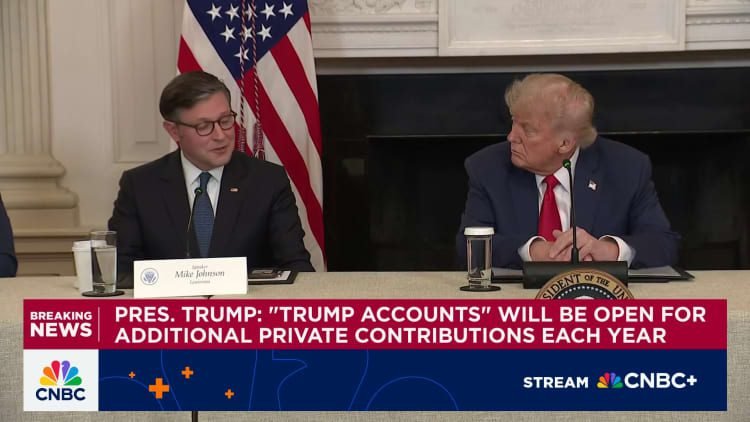Understanding the New Child Savings Account Proposal
President Donald Trump has introduced an extensive tax and spending initiative that features an innovative child savings account program design aimed at promoting financial literacy and wealth-building for American families. This initiative includes a one-time federal contribution of $1,000 for newborns as part of the so-called "Trump accounts."
What Are Trump Accounts?
Starting in July 2026, these Trump accounts will be available to all U.S. citizens born from January 1, 2025, to December 31, 2028. The primary goal is to encourage savings among young Americans with a straightforward foundation: each eligible child will receive a $1,000 initial deposit funded by the Department of the Treasury, irrespective of family income levels.
Funding Mechanics of Trump Accounts
Under this new proposal, parents, relatives, or anyone can contribute up to $5,000 annually in after-tax income until the child turns 18. Employers may also contribute up to $2,500 per employee’s account. This amount won’t be considered taxable income for the child. Moreover, both contribution limits will be adjusted for inflation over time.
The funds in these accounts will typically be invested in a low-cost index fund that mirrors the performance of a U.S. stock index. From a tax viewpoint, these accounts operate similarly to an individual retirement account (IRA), allowing the earnings to grow without immediate tax implications. Furthermore, withdrawals that qualify will usually be taxed as standard income.
Accessing Funds in Trump Accounts
While the setup appears beneficial, accessing these funds presents complexity. Generally, withdrawals cannot be made until the child turns 18. After this age, the account functions like a traditional IRA, limiting penalty-free withdrawals until the account holder reaches 59½ years old.
Previously proposed versions of this account would have allowed withdrawals for specific expenses like higher education or purchasing a first home immediately at age 18. However, under the final regulations, account holders must adhere to standard IRA rules, which impose penalties for early withdrawals.
Although there are escape routes from the IRA’s early withdrawal penalties—such as using funds for qualified education costs or first-time home purchases—the mixed nature of contributions and investment growth means that the distributions will still be partially taxed.
Child-Centric Retirement Savings
Experts describe Trump accounts as a kind of retirement plan tailored for children, emphasizing the importance of starting wealth accumulation early without requiring a traditional source of income. However, the investment spectrum remains limited to stocks, which could restrict diversification opportunities that might be more advantageous for long-term financial health.
Once the child turns 18, the investment rules may shift, granting the beneficiary a wider array of investment options.
Advocates for Wealth-Building
Supporters of Trump accounts argue that they will familiarize more families with financial investment opportunities. Sen. Ted Cruz, who has been influential in promoting this initiative, mentioned that these accounts could fundamentally change the economic trajectory for children by harnessing the power of compound growth, thereby facilitating wealth accumulation.
Initial Deposit Benefits
As an attractive feature, the upfront $1,000 deposit enhances the appeal of Trump accounts. While some states already manage similar programs, most tax professionals emphasize that this initial contribution is a significant advantage for children born during the specified timeframe.
Financial advisors often encourage taking full advantage of government offerings. "If the government provides free money, families should seize that opportunity," stated one financial planner.
Alternatives to Trump Accounts
Despite the benefits, many financial experts recommend considering a 529 college savings plan instead. These plans offer greater contribution limits and tax advantages. For instance, individuals can contribute up to $19,000 per child without affecting their lifetime gift tax exemption, with couples able to double this amount.
Additionally, 529 plans typically provide age-appropriate investment portfolios that gradually shift from aggressive equity investments to more stable, conservative options as college nears. This strategy may mitigate potential losses during market downturns.
Recent Flexibility in Fund Usage
Though 529 plans have specific restrictions, they have become more flexible in recent years, accommodating withdrawals for apprenticeships or continuing education courses. As of 2024, families will also have the option to transfer unused funds from a 529 account to a Roth IRA without any tax or penalty implications, provided specific requirements are met.
In discussions about comparing the two options, experts mostly lean toward endorsing 529 plans due to their flexible investment opportunities and advantages.
Conclusion
In light of financial literacy and savings, the introduction of Trump accounts presents a noteworthy development in how families can manage long-term wealth. However, the limitations and intricacies involved prompt further evaluation against other established savings options, such as 529 plans, which may better serve the financial goals of many families. As the proposal unfolds, ongoing dialogue and clarification from financial authorities will be essential for families navigating this new terrain.
